
Discover 21 common teaching challenges in Introduction to Business and effective, innovative strategies to overcome them.
Here are 21 examples of common pain points or challenges faced by Introduction to Business instructors, along with unique or surprising ways to address them.
Challenge: Students struggling with real-world applications of business theory
Solution: Implement a reverse teaching model where students first examine real-life case studies of companies facing specific challenges. Then, have them work backwards to identify which business principles or theories were applied in these cases. This method positions theory as the key to solving problems, giving students a practical context for abstract concepts.
Enhancement: Incorporate a "Business Theory in Action" project where students shadow local businesses or conduct interviews with entrepreneurs. They can then create multimedia presentations linking their observations to course theories, fostering a deeper understanding of how theoretical concepts manifest in real-world scenarios.
Challenge: Lack of connection between business education and students' personal interests
Solution: Offer personalized business projects that allow students to apply business principles to a field they are passionate about. For example, if a student loves gaming, they can create a mock business plan for an esports startup, while a student passionate about the environment can focus on a sustainable business model.
Enhancement: Introduce a "Business Passion Project" where students not only create a business plan but also prototype a minimum viable product (MVP) for their idea. This could involve creating a simple website, developing a basic app prototype, or even producing a small batch of a physical product. This hands-on approach helps students see how their interests can translate into viable business opportunities.
Challenge: Outdated examples in textbooks and materials
Solution: Adopt the most update textbook on the market, Business in Action. Also, use a live "Business News Breakdown" segment each week where students bring in the latest news stories about current business events, innovations, or trends. The class discusses how these stories connect to the material being covered, bringing real-time relevance to the classroom.
Enhancement: Create a class blog or podcast where students take turns analyzing and presenting current business news. This not only keeps the content fresh but also helps students develop important skills in content creation, analysis, and presentation. Invite local business leaders or alumni to comment on or guest-star in these student-led productions, adding an extra layer of real-world connection.
Challenge: Instructors feeling pressured to cover too much content in limited time
Solution: Adopt a flipped classroom model where core content delivery (videos, readings) is shifted to outside of class. Class time is then dedicated to deeper discussions, hands-on activities, and real-world applications.
Enhancement: Implement a modular curriculum design where the course is divided into core and elective modules. Cover the essential core modules in class, and allow students to choose from a selection of elective modules for self-study or group projects. This approach ensures all crucial topics are covered while giving students the flexibility to deep-dive into areas of personal interest.
Challenge: Keeping students engaged in large, impersonal lecture settings
Solution: Incorporate breakout groups where students take ownership of teaching small parts of the lesson. Rotate leadership roles so each student leads a micro-lesson during the semester.
Enhancement: Introduce a "Business Shark Tank" element to the course. Throughout the semester, students work in teams to develop a business idea. In the final weeks, they present their ideas to a panel of guest judges (local entrepreneurs, alumni, or even actual investors). This culminating event not only keeps students engaged throughout the course but also provides a platform for applying all the concepts they've learned in a high-stakes, real-world simulation.
Challenge: Difficulty relating to students from non-business majors
Solution: Present business principles as "life skills" that can be applied to any career path. Highlight core concepts such as budgeting, leadership, and negotiation as skills everyone needs—whether they're going into healthcare, education, or creative fields.
Enhancement: Develop interdisciplinary case studies that showcase how business principles apply in various fields. For example, explore how a hospital uses supply chain management, how a school district applies marketing strategies, or how a theater company manages its finances. This approach helps non-business majors see the relevance of business concepts in their chosen fields and prepares them for the business aspects they'll encounter in any career.
Challenge: Resistance to learning about seemingly "dry" subjects, like accounting or finance
Solution: Use gamified learning tools such as competitions where students create the most profitable "mock company" using financial principles they've learned. Simulate stock market environments where students invest in hypothetical companies and track their portfolio's performance over the semester.
Enhancement: Introduce a "Financial Detective" role-playing game where students act as forensic accountants investigating financial fraud cases. This could involve analyzing real-world financial scandals, decoding complex financial statements, and presenting their findings in a mock court setting. This approach not only makes accounting and finance more engaging but also highlights their crucial role in maintaining ethical business practices.
Challenge: Difficulty in assessing student progress and understanding
Solution: Host a "Business Hackathon" where students work in teams to solve a real business challenge, such as improving a company's supply chain or increasing brand awareness.
Enhancement: Implement a semester-long "Business Simulation" where students manage virtual companies in a competitive marketplace. Regular "board meetings" can be held where students present their company's performance and strategies to the instructor and peers acting as board members. This ongoing simulation allows for continuous assessment of students' ability to apply business concepts in a dynamic, interconnected environment.
Challenge: Balancing foundational theory with real-world business practice
Solution: Use a "Theory-Practice Mashup" that integrates both: Start each lesson with a fundamental business theory, and immediately pair it with a real-world case study or current event that demonstrates the theory in action.
Enhancement: Partner with local businesses to create "Live Case Studies." Each semester, a local company presents a real challenge they're facing. Students work in teams throughout the course to analyze the situation, apply relevant theories, and develop solutions. The company provides feedback and potentially implements the best ideas, giving students a tangible connection between theory and practice.
Challenge: Low student motivation and lack of participation
Solution: Offer "Participation Challenges" with tangible rewards such as extra credit or digital badges. Gamify participation by introducing a class leaderboard and offering real-time feedback.
Enhancement: Create a "Business League" where students form "companies" at the beginning of the semester. These companies compete in various challenges throughout the course, earning points for participation, quiz scores, project quality, and even peer evaluations. The league standings are updated weekly, with the top-performing companies earning real-world prizes like mentorship sessions with successful entrepreneurs or site visits to innovative companies.
Challenge: Students feeling disconnected from business professionals and industry trends
Solution: Organize live virtual guest lectures or Q&A sessions with entrepreneurs, business leaders, or industry experts. Bring in local business owners or recent alumni who can speak to the challenges of starting a business or navigating early career stages.
Enhancement: Establish a "Business Mentor Network" where each student is paired with a business professional for the duration of the course. These mentors can provide ongoing guidance, share real-world experiences, and even collaborate on course projects. This not only connects students to the business world but also helps them build valuable professional relationships that can extend beyond the course.
Challenge: Lack of real-world exposure to different industries
Solution: Implement "Industry Spotlights" where each week focuses on a different sector, such as healthcare, tech, retail, or finance. Use guest speakers, case studies, and hands-on activities to give students an inside look at how business operates across these sectors.
Enhancement: Organize "Virtual Industry Immersions" where students spend a week virtually embedded in a specific industry. This could involve virtual tours, online shadowing of professionals, participating in industry-specific webinars, and completing industry-related micro-projects. By the end of the course, students will have gained in-depth exposure to multiple industries, helping them make more informed career decisions.
Challenge: Students not seeing the global aspect of business
Solution: Create a "Global Business Challenge" where students are tasked with solving a business problem specific to a foreign market. This could involve considering cultural differences, legal constraints, or regional market conditions.
Enhancement: Implement a "Global Business Simulation" where student teams manage virtual companies operating in different countries. Each team must navigate cultural differences, international trade regulations, currency fluctuations, and geopolitical events. Regular "Global Summit" presentations allow teams to share their strategies and learn from each other's experiences in different markets.
Challenge: Students feeling business education is disconnected from pressing global issues
Solution: Integrate corporate social responsibility (CSR) and sustainability into your curriculum. Use real-life examples of companies that have successfully integrated sustainability into their business models, such as Patagonia or Tesla.
Enhancement: Launch a "Sustainable Business Innovation Lab" where students work on developing business solutions to address UN Sustainable Development Goals. Partner with NGOs or social enterprises to provide real-world context and potentially implement student ideas. This approach not only connects business education to global issues but also showcases how business can be a powerful tool for positive change.
Challenge: Limited student access to industry professionals and networks
Solution: Create "virtual networking" events, where students can interact with alumni, business leaders, and entrepreneurs via video conferencing platforms. These events could include speed networking sessions or virtual roundtables where students can ask questions and learn about career paths.
Enhancement: Develop a "Career Pathways Program" where students choose a specific business career track (e.g., marketing, finance, entrepreneurship) and gain access to tailored networking events, skill-building workshops, and mentorship opportunities within that field. This focused approach helps students build deeper connections in their area of interest and gain a clearer understanding of potential career trajectories.

Incorporate technology showcases into lessons, focusing on how emerging technologies like AI, blockchain, and automation disrupt industries.
Challenge: Students not understanding the impact of technology on modern business
Solution: Integrate technology showcases into the curriculum. Dedicate classes to discussing emerging technologies like blockchain, AI, and automation, and how they're disrupting industries from finance to healthcare.
Enhancement: Create a "Tech Entrepreneurship Incubator" within the course where students form teams to develop tech-based business ideas. Provide access to basic coding workshops, design thinking sessions, and mentorship from tech entrepreneurs. The incubator culminates in a "Tech Startup Showcase" where teams present their ideas to a panel of tech industry professionals, potentially leading to further development opportunities.
Challenge: Overemphasis on traditional corporate structures and career paths
Solution: Introduce non-corporate business models such as cooperatives, gig economy platforms, and remote work environments into the discussion. Provide case studies of successful startups and gig workers who have built careers outside of the traditional corporate world.
Enhancement: Implement an "Alternative Business Models Fair" where students research and present on various non-traditional business structures and career paths. Include workshops on freelancing, starting a cooperative, or building a personal brand. Invite successful individuals from these alternative paths to share their experiences and advice, helping students understand the full spectrum of business career possibilities.
Challenge: Students find it hard to see the human element in business decisions
Solution: Incorporate ethnographic studies or customer journey mapping into your lessons. Have students analyze how business decisions affect different stakeholders, from employees to consumers to the local community.
Enhancement: Introduce a "Stakeholder Impact Analysis" project where students follow a major business decision (e.g., a merger, product launch, or policy change) and conduct in-depth research on its impact across various stakeholder groups. This could involve interviews, data analysis, and even creating documentary-style presentations. By deeply examining the human consequences of business actions, students develop a more nuanced understanding of business ethics and decision-making.
Challenge: Difficulty in demonstrating the importance of soft skills in business
Solution: Implement soft skills workshops where students practice skills like negotiation, conflict resolution, and team management through role-playing exercises. Invite guest speakers who exemplify strong leadership and communication skills.
Enhancement: Create a "Leadership Lab" where students rotate through leadership roles in various team projects throughout the semester. Each role focuses on different soft skills, such as communication, emotional intelligence, or conflict resolution. Students receive peer feedback and reflect on their performance, creating a personal soft skills development plan. This hands-on approach helps students understand the practical importance of soft skills in business settings.
Challenge: Students unaware of the financial risks and rewards of entrepreneurship
Solution: Introduce entrepreneurial risk simulations, where students simulate launching a startup, taking on investors, and managing cash flow. Engage in mock fundraising rounds, calculating burn rates, and making real-time business decisions.
Enhancement: Develop an "Entrepreneurship Risk and Reward Game" that extends throughout the semester. Students start with a virtual pool of money and make investment decisions in various startup scenarios. These scenarios unfold over time, with students facing unexpected challenges, market shifts, and opportunities for growth. The game incorporates elements of chance to simulate real-world unpredictability, teaching students about risk management, opportunity cost, and the long-term nature of entrepreneurial success.
Challenge: Students' reluctance to embrace failure as part of the learning process
Solution: Introduce a "failure resume" assignment where students list their failures, reflect on what they learned from them, and discuss how those failures led to growth. Highlight famous entrepreneurs or business leaders who experienced failures before achieving success.
Enhancement: Implement a "Failure Lab" where students are encouraged to take calculated risks on experimental business ideas. Create a safe space for students to pitch unconventional ideas, test them in low-stakes environments, and analyze the results—whether successful or not. Celebrate "noble failures" where important lessons were learned, and host "Failure Wake" events where students share stories of their failures in a supportive, even humorous environment. This approach not only destigmatizes failure but also teaches valuable lessons in resilience, adaptability, and innovation.
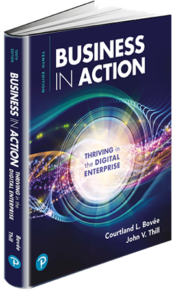 How Business in Action Empowers Instructors to Tackle the Biggest Challenges in Introduction to Business
How Business in Action Empowers Instructors to Tackle the Biggest Challenges in Introduction to Business
Business in Action by Courtland Bovee and John Thill is an outstanding textbook that equips Introduction to Business instructors with essential tools to address the common challenges they face, transforming their courses into dynamic and engaging learning environments. The textbook blends foundational business principles, real-world case studies, interactive learning strategies, and practical insights, making it an ideal resource for addressing pain points highlighted in the article “From Pain Points to Powerful Learning: Transforming Introduction to Business Instruction.” Below is an explanation of how Business in Action helps tackle these challenges and elevates the quality of business instruction.
Many students struggle with the real-world application of business theory, finding it difficult to see how abstract concepts connect to real challenges. Business in Action includes a wealth of real-life case studies and examples that help students bridge this gap. The textbook supports the reverse teaching model, where students analyze real-life business cases and trace them back to the theories they’ve learned. This not only improves understanding but also solidifies the connection between theory and practice, giving students a more practical context for abstract concepts.
Personalization is another key to student engagement. Business in Action makes it easy for instructors to offer personalized business projects, allowing students to apply business principles to areas they are passionate about. With examples that cover a wide range of industries, from small startups to large corporations, students can align their interests with course material. This flexible approach helps students create personalized business plans and projects, fostering creativity and a deeper engagement with business concepts.
One of the common struggles for instructors is outdated material. In a rapidly changing business world, staying current is crucial. Business in Action is among the most up-to-date textbooks, incorporating the latest trends such as AI, digital transformation, and sustainability. This ensures that students are not just learning theory but are also aware of its application in today’s business world. Instructors can enhance this by creating a “Business News Breakdown” segment in class, where students analyze recent business news, connecting it to the theories they’re studying.
Instructors often feel pressured to cover too much content in too little time. The concise and well-organized structure of Business in Action lends itself perfectly to a flipped classroom model, where students engage with core content—such as videos and readings—outside of class, freeing up valuable in-class time for deeper discussions and real-world applications. This model ensures that instructors can cover the essential topics without overwhelming students, allowing for more interaction and hands-on activities.
Engaging students in large, impersonal lecture settings is a challenge many instructors face. Business in Action supports active learning with group project prompts and discussion questions that can easily be adapted for breakout groups. This encourages students to take ownership of small parts of the lesson and keeps them engaged. Instructors can also introduce business simulations, such as a “Business Shark Tank,” where students develop and pitch business ideas throughout the semester. This real-world simulation not only keeps students engaged but also allows them to apply concepts learned in class.
Students from non-business majors often find it hard to relate to business concepts. Business in Action emphasizes broad, transferable skills like leadership, financial literacy, and communication, making business principles relevant to all fields. The textbook includes interdisciplinary examples, allowing instructors to demonstrate how business concepts apply in various fields such as healthcare, education, or the arts. This approach shows students from non-business majors the practical applications of business knowledge in their future careers.
For subjects like accounting or finance, which can seem dry to students, Business in Action offers engaging narratives and real-world examples to simplify complex topics. This makes it an ideal resource for gamified learning activities. Instructors can create mock companies where students compete to make profitable financial decisions, making these subjects more dynamic and hands-on. The textbook ensures that students grasp the importance of accounting and finance through practical, real-world scenarios.
Assessing student progress is another challenge instructors face. Business in Action emphasizes problem-solving activities and real-world simulations, offering instructors the tools to assess students more dynamically. For instance, a semester-long business simulation can allow students to manage virtual companies in a competitive marketplace, providing continuous assessment opportunities rather than relying solely on exams.
Balancing foundational business theory with real-world practice is critical for student success. Business in Action integrates theory with real-world case studies, making it easy for instructors to create a “Theory-Practice Mashup” where abstract concepts are immediately paired with practical examples. This method ensures that students see theory as a tool for solving real-world business challenges.
Keeping students motivated and participating can be a struggle, but Business in Action supports engaging activities that foster competition and teamwork. Instructors can introduce a “Business League,” where student teams compete in challenges throughout the semester. This fosters motivation through friendly competition, as students earn points for participation, project quality, and peer evaluations, making the course more interactive and fun.
One of the textbook’s standout features is its emphasis on connecting students to the business world. Business in Action includes interviews and real-life insights from industry professionals, giving students direct exposure to current trends and challenges. Instructors can build on this by organizing virtual guest lectures with entrepreneurs and business leaders or developing mentorship programs where students are paired with professionals throughout the course.
Exposure to different industries is essential for broadening students’ perspectives. Business in Action covers a wide range of sectors, including healthcare, tech, and retail. This makes it easier for instructors to organize “Industry Spotlights,” where students explore how different sectors operate. The textbook’s variety of case studies also allows for virtual industry immersions, where students gain in-depth exposure to multiple industries, helping them make more informed career decisions.
Understanding the global aspect of business is crucial, and Business in Action excels in covering international business principles. The textbook’s global case studies provide real-world examples of businesses navigating cultural and legal differences. Instructors can build on this by creating global business challenges where students solve business problems in foreign markets, learning to navigate the complexities of international business.
In today’s world, students often feel disconnected from pressing global issues. Business in Action integrates topics like corporate social responsibility and sustainability, demonstrating how business can be a force for positive change. Instructors can create “Sustainable Business Innovation Labs,” where students develop business strategies that address global challenges such as climate change or inequality.
Another challenge instructors face is providing students with access to industry professionals and networks. Business in Action bridges this gap by offering real-life business examples and insights that can be supplemented with virtual networking events or mentorship programs. These opportunities not only connect students with the business world but also help them build valuable relationships for future career success.
Technology is transforming the business landscape, and Business in Action provides comprehensive coverage of emerging technologies such as AI, blockchain, and automation. Instructors can build on this by creating “Tech Entrepreneurship Incubators” where students develop tech-based business ideas, preparing them for the fast-evolving business world.
The textbook also moves beyond traditional corporate structures, highlighting non-corporate models like cooperatives and gig economy platforms. This gives instructors the flexibility to explore alternative career paths, helping students understand the diverse range of business models and career opportunities available to them.
Understanding the human element of business decisions is a critical skill. Business in Action includes discussions on business ethics and stakeholder impacts, making it an excellent resource for teaching students how business decisions affect employees, consumers, and communities. Instructors can create projects where students analyze the impact of major business decisions across various stakeholder groups, fostering a deeper understanding of ethical decision-making.
Lastly, Business in Action emphasizes the importance of soft skills such as communication, negotiation, and leadership. These skills are embedded in the text through case studies and exercises, making it easier for instructors to create soft skills workshops where students practice these critical abilities in real-world scenarios.
Business in Action by Bovee and Thill is an ideal textbook for Introduction to Business instructors. Its comprehensive, real-world approach to business education, along with its flexibility and up-to-date content, makes it a powerful tool for addressing the diverse challenges faced by instructors. Whether it’s helping students understand complex theories, engaging them in practical projects, or connecting them to the business world, Business in Action provides the resources and framework to transform business education.
Read more


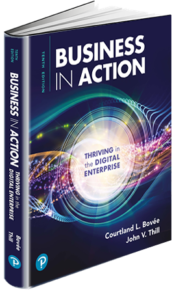 The Growth Mindset Revolution: Business in Action for Teaching Introduction to Business
The Growth Mindset Revolution: Business in Action for Teaching Introduction to Business




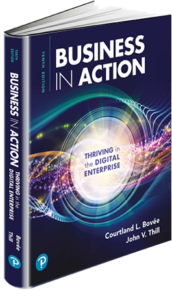








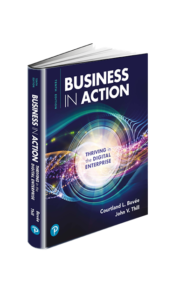

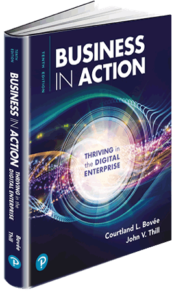
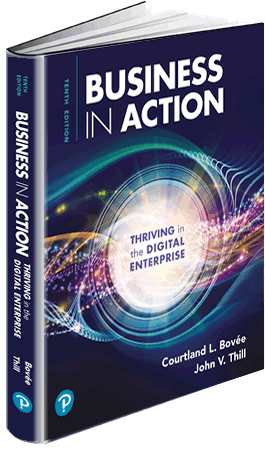 Business in Action, 10th Edition
Business in Action, 10th Edition